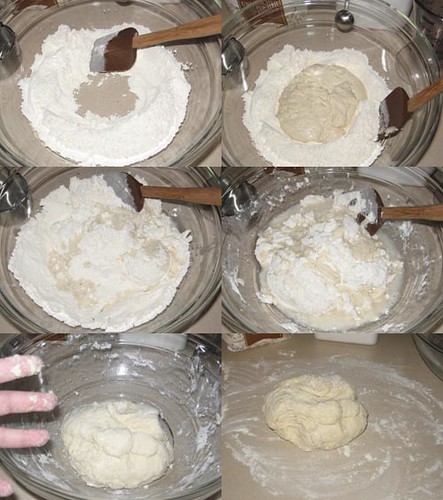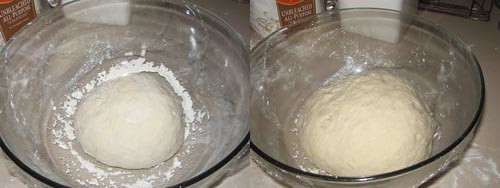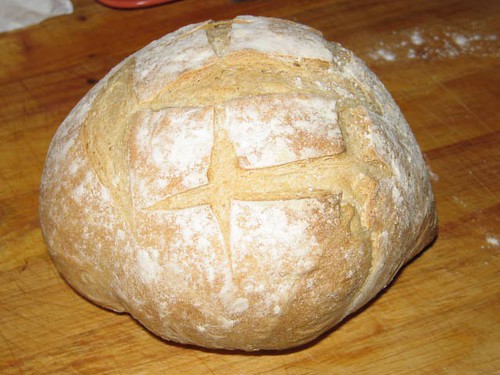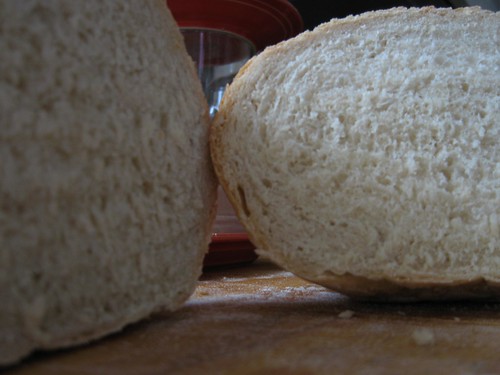Tragedy struck last week - I stripped the worm gear in my mixer and while the part's on order, it's out of commission. So today I was looking for a nice, simple by-hand bread recipe. You know, because supposedly people do bread all the time without the benefit of mixers. =)
I turned to [i]Savory Baking from the Mediterranean[/i] by Anissa Helou and found a recipe for French Country Bread that had only 3 ingredients - 4 if you count water-based ingredients:
1 ½ teaspoons (2/3rds package) active dry yeast
2 2/3 cups unbleached all-purpose flour, plus extra for kneading and shaping
1 ½ teaspoons fine kosher salt or sea salt
10 to 15 ice cubes
So, I got my ingredients together and got ready to go by hand:

I went with Kosher salt and obviously the ice cubes are hiding out in the freezer since they won't be used for a few hours.
From Savory Baking:
[i]1. Dissolve the yeast in ½ cup warm water in a medium bowl. Add 1 cup of the flour. Mix with a spoon to make a very wet dough. Cover with plastic wrap and let rise in a warm, draft-free place for 3 hours. This is the poolish.[/i]
This was easy stuff. The only adjustment I had to make was in the rise time. Since I was using a quick-rise yeast, I cut the rise time down to 1 hour 45 minutes - the pooish was big and bubbly at that point. The mixing photos:

From Savory Baking:
[i]2. Combine the remaining 1 2/3 cups flour and the salt in a large bowl and make a well in the center. Add the poolish to the well and gradually and ½ cup warm water, bringing in the flour as you go along. Knead briefly to make a rough, quite wet ball of dough.[/i]
I treated this as if I were folding in egg whites to the flour. It worked really well up until the end, at which point it could only be done by hand. It wasn't so much that it was "wet" as it was sticky, but definitely workable:

From Savory Baking:
[i]3. Remove the dough to a floured work surface and sprinkle the dough with more flour. Knead for 3 minutes, sprinkling with more flour if necessary. Invert the bowl over the dough and let rest for 15 minutes. Knead the dough for about 2 to 3 minutes more, until it is smooth and elastic. Shape the dough into a ball, place in a lightly floured clean bowl, and cover with plastic wrap. Let rise in a warm, draft-free place for 1 hour. Fold the dough, cover again and let rise for 1 hour more. The dough should have doubled in volume.[/i]
The kneading was smooth and as promised:

BUT after the first rise - which I cut down to 30 minutes instead of an hour due to the quick rise - I had already doubled:

At this point, knowing the instructions are calling for yet another rise, I decided to not risk tiring out my yeast. My dough had huge air bubbles at this point already. I skipped the 2nd rise from the previous step and I moved onto step 4.
From Savory Baking:
[i]4. Return the dough to the work surface. Shape gently into a tight ball, taking care to deflate as few air balls as possible. Place on a large nonstick baking sheet or on a baking sheet lined with parchment paper or a silicone pastry mat. Cover with a wet but not dripping kitchen towel and let rise for 1 hour, until doubled in volume. Meanwhile, preheat the oven to 450 degrees. Place a medium baking dish on the bottom of the oven.[/i]
I made quite a few adjustments. I decided to heat up my pizza stone for baking, so I didn't bother with baking sheets, parchment paper or silicone baking mats. I used my pizza peel as a resting/rising surface, dusting it like crazy with flour. I warmed a cake pan in the oven at the same time I was warming my pizza stone. The construction for my ball was rather quick since I was trying to be careful with the dough. My rise seemed to go mostly up:

From Savory Baking:
[i]5. Sift a little flour over the bread. With a lame, preferably, or with a razor blade or very sharp knife, carefully cut a square pattern over the top. Immediately before baking, toss the ice cubes into the baking dish onto the oven bottom to create steam. Bake for 15 minutes, reduce the heat to 350 degrees, and bake for 35 to 40 minutes more, until golden brown. Transfer to a wire rack to cool. Serve warm or at room temperature, or reheated.[/i]
At this point, I'm on point with the instructions. I actually use a very sharp fish fillet knife to score bread - and for fun and games, find the ones where I did not apply a light enough touch!

Baking goes well and the rise up seems to continue:

Even better, a nice substantial bread without being overly heavy:

The taste? Suprisingly good for so little! The poolish gives the bread a little bit more oomph in the flavor department with an extra amount of fermentation. By mixing in just [i]enough[/i] flour, the little bit of kosher salt comes through as a plesant suprise. The steam from the ice cubes, while no steam-injected oven, still offers up a nice chewey crust.
Sure, this guy's a little time-consuming, but when you realize you'll use 3 cups of flour and a little yeast and salt...and you've got to freeze some water...well, what have you got to loose?
- Stephmo's Blog
- Log in or register to post comments
Your bread looks really good! I love using preferments, like poolish, because you get such a deeper flavor with very little effort.